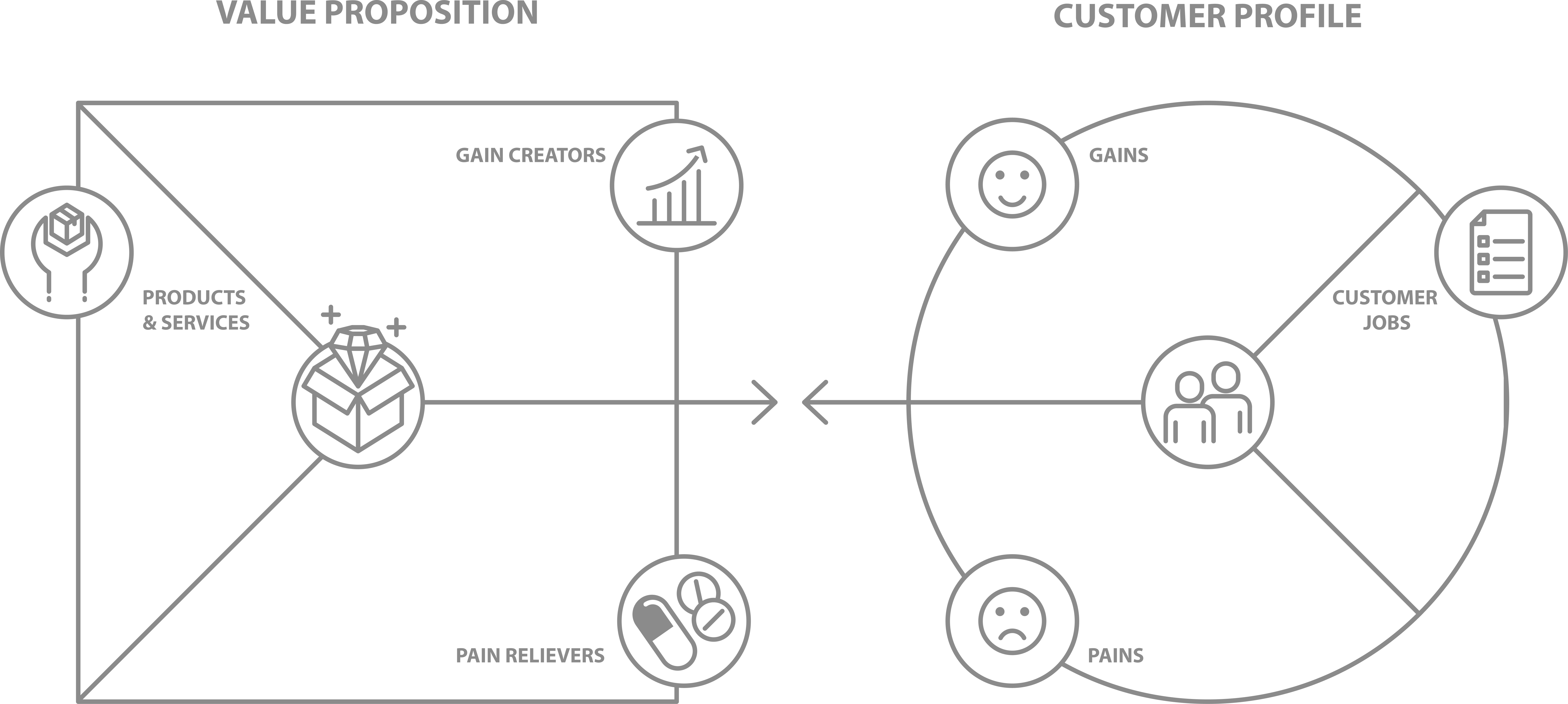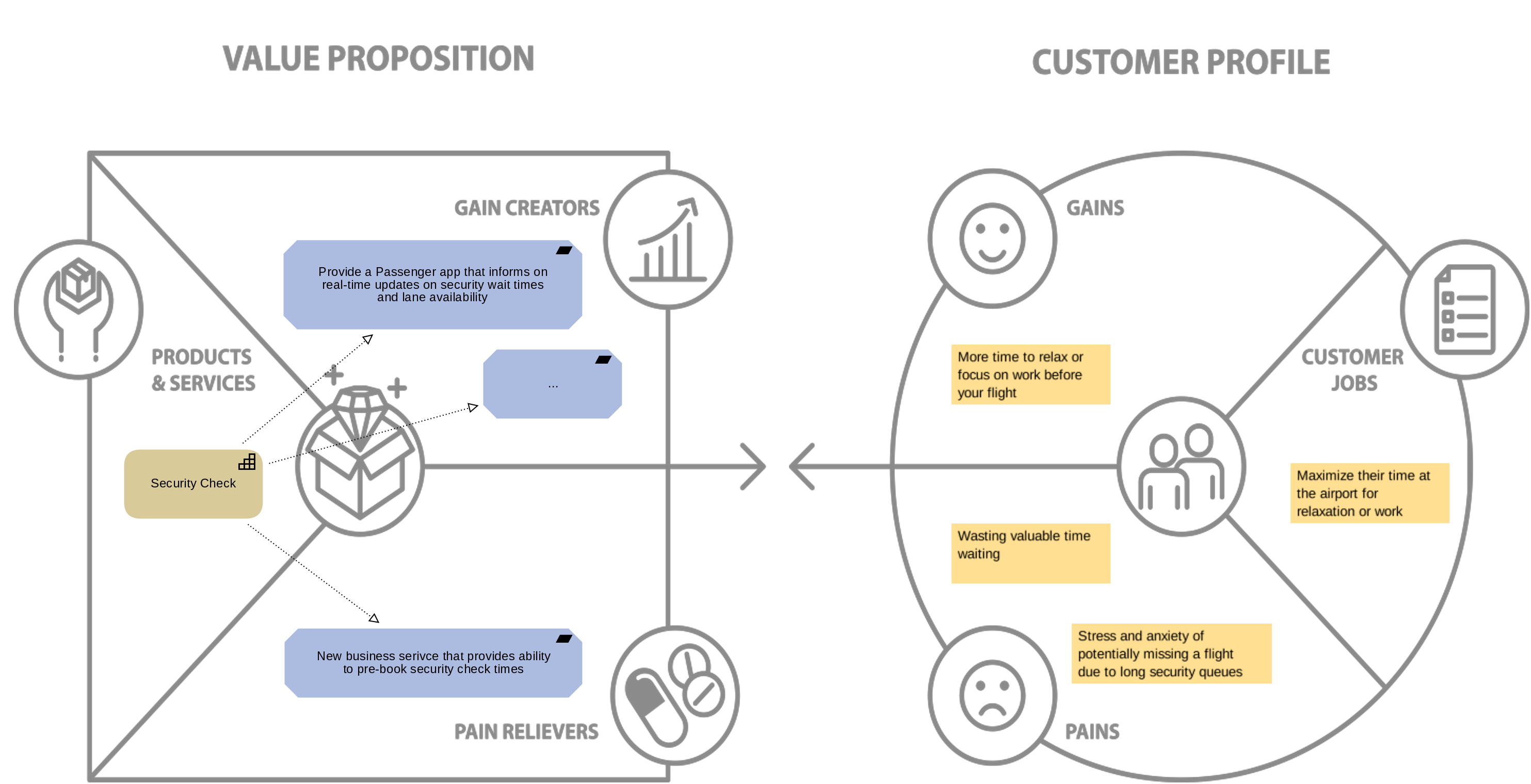Found this helpful? Share it with peers.
Introduction
The creation of the architectural vision serves as a crucial compass that guides architects in aligning their strategies with business goals and technological advances. However, a common mistake is to focus directly on business goals and organization-wide challenges, neglecting the personal concerns of key stakeholders, be they customers, partners, or employees.
However, the importance of a people-centered Enterprise Architecture cannot be overstated. Read on to find out why.
What is the Value Proposition Canvas?
The Value Proposition Canvas is a strategic tool designed to help businesses ensure that their product or service aligns with the needs and desires of their customers. It consists of two main components: the Customer Profile, which outlines customer jobs, pains, and gains, and the Value Map, which details how the product addresses those elements through features, benefits, and unique selling points. By visualizing these components, organizations can identify gaps, optimize their value proposition, and enhance customer satisfaction and engagement, ultimately driving growth and competitive advantage.
Taking a people-centric approach
A people-centered approach to Enterprise Architecture focuses on the needs and experiences of individuals within the organization. What is more, the people-centered EA comes with benefits that not only lead to better outcomes but also increase the overall acceptance of EA initiatives:
- Enhanced Collaboration: Putting people at the center of Enterprise Architecture encourages collaboration between all stakeholders. By understanding their needs, goals and challenges, you can develop tailored solutions that address specific problems and achieve better results.
- Increased Adoption: Stakeholders develop a deeper familiarity and sense of ownership over solution designs, facilitating their comprehension and adaptability to changes.
- Improved Decision-Making: By considering the perspectives of the various stakeholders, you can better assess the potential impact of your designs and choose the most appropriate measures.
- Greater Agility: Placing people at the forefront enables companies to swiftly adjust to change by tailoring solutions to stakeholders’ needs, fostering intuitive user experiences, and facilitating seamless adaptation to new technologies.
- Enhanced User Experience: Your EA initiatives prioritize enhancing the user experience, whether for internal employees navigating systems or external customers engaging with your organization. This focus on people’s needs enables you to craft intuitive, user-friendly, and highly effective solutions.
Value Proposition Canvas in 5 Simple Steps
The Value Proposition Canvas, developed by Alexander Osterwalder, is a strategic tool that helps businesses understand and design products or services that effectively address customer needs and create value. In your EA initiatives, the development of a convincing value proposition will serve as a protective shield against uncertainty and will minimize two types of risk:
- Firstly, there is backstage risk, which includes challenges such as technological feasibility, infrastructure readiness and cost viability – essentially: “Doing It The Right Way”.
- Secondly, the market risk is in front of the stage, i.e. from the customers’ perspective. This encompasses whether our solutions are appropriately positioned in the market and whether they are well-received by both customers and employees, essentially ensuring we’re “Doing The Right Things.“
CB Insights reports that 42% of start-ups fail due to insufficient market demand, often stemming from an inability to validate their value proposition. Are established companies exempt from this risk in their project plans?
This is where the value proposition canvas comes into play. It is used to find the ideal product x market fit for your solution (designs).

The typical value proposition canvas. The starting point for your workshops.
Utilizing the canvas in your EA initiative is straightforward – simply fill in the fields. However, don’t tackle this task alone. Engage a diverse group across your organization to ensure a successful, consensus-driven outcome. Here’s how:
- Define Customer Segments: Use the VPC to identify and profile different stakeholder segments, e.g. business managers, IT teams, end users and external customers. If you have very heterogeneous groups, you can fill in the canvas for each of these personas.
- Identify Customer Jobs: The “jobs” in the VPC represent the tasks, goals and objectives that the stakeholders are trying to achieve. By talking to the stakeholders, you can identify their main tasks. For example, business leaders may focus on driving revenue growth, while IT teams may be concerned with the scalability and performance of application components.
- Pinpoint Pains and Gains: Pains are the challenges, frustrations and obstacles stakeholders face, while gains are the benefits, hopes and aspirations they strive for. Use the VPC to capture the specific pains and benefits of each stakeholder segment. For example, business leaders may have pains related to outdated technologies that hinder innovation, while end users may desire more intuitive user interfaces for increased productivity.
- Mapping Solutions: Once you have a clear understanding of stakeholder needs, pains and benefits, use the left side of the VPC to develop solutions that fulfill those needs. This includes articulating the capabilities, products, business services, and application services that provide value to stakeholders. For example, solutions could include implementing a cloud-based infrastructure to solve scalability issues or developing user-friendly interfaces to improve the user experience. Try not to go into detail. For EA initiatives, it is usually enough to identify the business capabilities involved. Gain creators can be mapped as requirements. These must then be prioritized and planned accordingly.
- Iterative Validation: It is important that you iterate and validate your value propositions with stakeholders. Use the VPC as a tool for continuous engagement and feedback gathering to ensure that your solutions continue to align with stakeholder needs and expectations over time.
Make the Value Proposition Canvas part of your EA
An example of a value proposition at an airport.
The example above offers a solution for the long waiting times at the security checkpoint. Please note that we already use ArchiMate elements in the value proposition part – on the left side. This way, the results of our value proposition can be inserted into any other EA view.
Hint: Kickstart your value proposition refinement using our free Value Proposition Canvas template.
While the value proposition canvas is often created with paper and pencil, ArchiMate and the EA Tool ADOIT offer additional advantages:
- The requirements derived from the Value Proposition Canvas can be prioritized, scheduled and tracked directly with your roadmaps. Their impacts on the architecture become visible.
- Many solution designs lack the “Why”. By linking the value proposition with the requirements to be implemented, the need for change becomes comprehensible for enterprise architects and more importantly for your business stakeholders. Value propositions and the resulting requirements can be seamlessly integrated into existing architecture views, such as your operating model designs.
- In your portfolio views those elements that are directly related to value propositions become highlighted.
Summary
Embedding stakeholder engagement practices into the Enterprise Architecture ensures its integration into the fabric of the organization. By incorporating different perspectives into decision-making processes, businesses can drive alignment, foster innovation, and enhance overall performance.
In conclusion, prioritizing stakeholder engagement through a people-centric approach is essential for organizations seeking to thrive in today’s competitive landscape. By visualizing stakeholders’ needs, leveraging tools like the Value Proposition Canvas, and integrating engagement practices into Enterprise Architecture, businesses can build stronger relationships, drive innovation, and achieve sustainable success.





